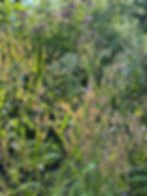An Exuberant Native Garden
- Nuts for Natives
- Sep 17
- 5 min read
Zero to sixty in six years!

Rujuta and Rahul, neuroscientists at the Lieber Institute, part of Johns Hopkins Medicine, moved to the Towson area and inherited a typical suburban tableau: a lovely street lined with well kept homes, green lawns and specimen trees. In short order, COVID arrived and Rujuta found herself at home a lot more. She decided to tackle the rainwater drainage on their steeply sloped lot.
Rujuta, no stranger to research, made quick connections and eventually ended up working with Patty Ceglia of Ecological Design and Education. First step: a native garden assessment to harness rainwater that was running right down to the curb. Patty calculated the volume of water and degree of slope and recommended a full native garden for the front of the home with a network of mulched paths that would naturally serve as rainwater absorption swales. Rujuta and Rahul were all in.
Each swale, now a mulched path, was dug down about a foot and a half and lined with sand, crushed gravel and compost. The idea is that rainwater will drain by gravity into the swales, seep down into the ground and be absorbed by the plants lining the swales rather than run off into the street.
Soon thereafter, the Narurkars were contacted by a reality t.v. show called "Kill Your Lawn," an ecological extreme makeover show advocating for native plants. Again Rujuta and Rahul were immediately all in. When I asked what made them so quick to say yes to totally transforming the front of their house all in one go, Rujuta mentioned reading about Doug Tallamy's conservation work and Rahul reminded Rujuta of her love for a 1985 Studio Ghibli Japanese anime film called Nausicaä of the Valley of the Wind, a post-nuclear war period drama. They came across the movie in 2000. Rujuta explains the plot as saving a pristine valley from a toxic fate with Princess Nausica’s deep understanding and revelation of how flora and fauna play critical roles detoxifying nuclear waste. This film was Rujuta's environmental 'aha' moment and she envisioned a front garden filled with native flowers, pollinators, and plants for wildlife as her small, but satisfying, contribution to the vast ecological community.
In October 2023, true to the Kill Your Lawn model, Rujuta and Rahul’s front lawn vanished in a matter of days. A few yew shrubs and a rose or two were left. Otherwise it was a total makeover!
The three of us talked about this fascinating journey while standing among 7, 9 and 11 foot tall flowering plants gently swaying in the late August breeze. At one point I interrupted to say I have always dreamed of being in a garden where I was comfortably and completely surrounded by beautiful flowers and butterflies and pollinators talking with people who loved gardening and here I was!

Rahul explained this front garden is a very deeply needed connection to the natural world. Having grown up in bustling Mumbai and then moving to New York City, and with a challenging job researching the brain, he was, like many, living in a fast moving world with a fast moving lifestyle. He says this garden has shown him a different way. Even ten minutes in his garden after arriving home from work makes all the difference in the world. I think a lot of us feel that way about our gardens. Rahul has the rationale behind it though. He says brain science shows how important experiences like this are for our brains' health. He explains "the brain, to stay healthy, needs to strengthen internal neuronal connections and personal space moments like these - in one’s own garden - can do that for us."
This full sun garden with its drainage swales is thriving. Thriving is actually an understatement... it's energetic, abundant, exuberant! Full of life and then some! We laughed about the tried but true gardening notion that in the first year plants sleep, in the second year they creep and in the third year they leap. This is the second year so if this is creeping, what will leaping bring?! What this really shows is the plants are just the right plants for the conditions and the drainage swales are absorbing the water that moisture loving plants like joe pye weed (Eutrochium), new york ironweed (Vernonia novaboracensis), cutleaf coneflower (Rudbeckia laciniata), lobelia (Lobelia siphilitica) and blue vervain (Verbena hastata) grow so well in.

Rabbits soon joined the front garden and Rahul realized they were munching the northern sea oats (Chasmanthium latifolium), another moisture loving plant. He planted mountain mint (Pycanthemum muticum) next to each of the sea oats as it is reported to be unattractive to rabbits. Rahul reports it seems to be working. I would add that this is a plant combination I would not have thought of. The muted neutral colors of both are complementary and look so ethereal. They also provide periodic points of calm amidst the abundance of growth.
Given the amount of height in the front garden in year two, Rahul plans to do some editing this fall. Moving the taller plants to the top of the slope and shorter plants to the street level will soften the garden’s profile to passersby.
Already he has noted that monarch's delight, aka butterfly weed (Asclepias tuberosa), did not do well at the top of the slope but reseeded itself at the foot of the slope, curbside, where it clearly prefers to live. Rajul says the plant is teaching us its place, and we’re leaning into its wisdom, keeping the curbside edge low.
Rujuta and Rahul have allowed the same aesthetic to prevail in their back garden which is mostly shaded by large white pines (Pinus strobus) and other trees. They are expert at letting things be - a lesson we could all benefit from.
During the Pandemic, they added a three-tier pond that now hosts frogs, dragonflies and damselflies, and on lucky August evenings, even a visiting blue heron. Native shrubs like elderberry (Sambucus canadensis), cranberry viburnum (Viburnum opulus var. americanum) and beautyberry (Callicarpa americana) are thriving at the edges of the pond.
Rujuta and Rahul are also very attuned to removing invasive plants, those plants that have a negative effect on our natural areas. A mature river birch (Betula nigra) has a bed of English ivy (Hedera helix) beneath it. It's of a size that is probably manageable for removal by hand. Another method I have not tried but many have told me works well is repeated mowing to weaken the ivy.
This garden inspires for so many reasons. First is Rujuta and Rahul's quick decision making, While based on science, they say it comes from the heart. They are also teaching all of us. Their garden was chosen as top garden in the 2024 Green Towson Alliance native garden contest, has been visited by Wild One's Chapters and is becoming somewhat legendary.
Their true delight? Rahul spotted the tiniest of monarch caterpillars, less than an inch long but feeding away on the milkweed. Now that's inspiring!
Happy Gardening.
















































